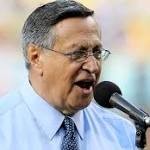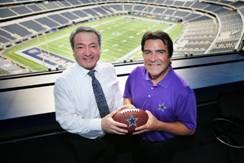
By Les Carpenter
In 1959, a 23 year-old from Ecuador began calling Dodgers games in Spanish. Nearly 60 years later he is still working – and has helped transformed the team’s fanbase.
They come with their fathers, they come with their mothers. They come with their grandmothers and grandfathers and uncles and aunts, some of them dabbing tears from their eyes. They stand outside the Vin Scully Press Box at the LA Dodgers’ stadium on Vin Scully Avenue waiting not for Vin Scully, known as baseball’s greatest announcer, but for the Spanish language Vin Scully; the voice of their lives. And when he emerges from the elevator, they embrace him and ask for photos and then they beg that he never, ever leaves.
“So many people they come up to me and say: ‘My father used to hear you, my grandfather, my grandmother … and so we started growing up together,’” the Dodgers Spanish language broadcaster Jaime Jarrín says softly. “It really pleases me to hear that.”
Lost behind the year-long farewell to Scully is a remarkable story. It’s a story many baseball fans don’t know because when they think of the Dodgers they think only of Scully, the team’s narrator for nearly 70 seasons and a man who calls games in such vivid detail he was voted into the Hall of Fame more than 30 years ago. Even as they mourn Scully’s October retirement, they have barely heard of the regal 80-year-old legend in Scully’s shadow. Nor do they realize that for 58 years, millions of southern California Latinos have had a Vin Scully of their own. And that without him the Dodgers might not be the $2bn franchise they’ve become.
“I think we opened the door to some organizations to realize how important the Latino market is,” Jarrín says.
And that market matters.
In the winter of 1958 Walter O’Malley moved his Brooklyn Dodgers to Los Angeles. Being a businessman he looked around the vast, booming city and he saw opportunity in immigrants from Central and South America with no understanding of American sports. He would make them baseball fans by not only broadcasting each game in English but in Spanish too. No team had ever done something like this before, putting every game on Spanish radio. But O’Malley dreamed that someday these new fans would flock to the stadium he was building on a hill above downtown LA – a hill once-populated by Mexican immigrants who had been pulled from their homes in part for the ballpark’s construction.
The man who came to be O’Malley’s Spanish broadcaster barely knew baseball then. He was 23 years old and had arrived three years before on a boat from Ecuador. But soon Jarrín was telling the same Dodger story as Scully, only to an audience that didn’t know Scully. And they did listen, And they did come to his ballpark on the hill, driving from places like Bakersfield and Fresno, several hours away, lured by the story of a team that Jarrín told nightly. Now nearly half of the Dodger Stadium crowd is Latino, and a little less then half of that group speak Spanish as their first language.
“In the Mexican community in Southern California, I don’t know if Jaime is God-like but he’s at least a notch below,” says Charley Steiner, who broadcasts Dodgers games in English. Then he laughs. “I’m so lucky,” Steiner continues. “I have two of the greatest broadcasters of all time to go to work with every day.”
Jarrín stands outside the Nationals Park press box on a scorching Washington afternoon watching the Dodgers take batting practice. He still travels with the Dodgers, covering every game on every trip. His only exception is a small vacation he takes each summer. He figures that he’s earned the right after more than five decades. Otherwise he keeps flying on the planes, moving from hotel to hotel, climbing press box staircases because he enjoys the grind of baseball and the camaraderie of being around a team. He wants to do this for two more seasons, until he reaches his 60th in the game before deciding if he will cut back. His wife, Blanca, who he married long ago back home in Ecuador continues to let him go. He promises her he will stop the moment she asks. So far she hasn’t. Maybe she understands how vital his voice is to a population that looks forward to hearing it the way LA’s English-speaking fans take comfort in Scully’s.
“I am so blessed doing what I do,” he says. “I have the best seat in the house and [am] respected by my colleagues. I respect everybody in the organization, I demand respect and they do that, I am very well paid. The main thing is: I love what I do. Most people hate what they do.”
A few years ago, Jaime’s son Jorge became his broadcast partner. Each morning they have lunch together and share a ride to the stadium where they sit side-by-side, switching every three innings. Jorge talks a lot about statistics and Jaime likes that. It allows him to tell stories. To him, his nightly conversation with Southern California is a public service. He knows his listeners. They are the working people; the ones who leave home at 6am and don’t come back until after 5pm. They are tired by day’s end, they need a diversion and his Dodger broadcasts are their refuge.
“It’s a chance for me to give them something they can enjoy,” he says. “Something that can really relax them.”
He constantly worries about doing that. He is a worker too. For years he did radio news stories for Spanish language station KWKW in Pasadena, in addition to baseball, only giving it up a decade ago. He has covered riots and protests and presidents. He was the only Spanish-speaking reporter to be at John F Kennedy’s funeral, flying to Washington that day without a credential and calling on a Latino congressman who got him a pass and a car within an hour. He became the first Spanish-language journalist in Southern California to win a Golden Mike Award for his coverage of the 1970 Chicano Moratorium. He later won another. For a few years, he was also the sports director at Telemundo 52 in LA, giving the job up when he found he loved radio more than TV. He remembers a five-year period where he worked from 4am to 1am six days a week and he wonders now how he managed to keep going.
But then Jarrín was aways a newsman. His first radio job came when he was 15 reading news and writing scripts for station HCJB – “The Voice of the Andes” – in his hometown of Quito, Ecuador. Two years later, he was the official announcer for the Ecuadoran senate. He could have had that job forever but he longed for something bigger. Bianca, who he married at 18, urged him to search saying she would follow wherever he went. That opportunity came when after interviewing the American consul in Quito, he told the man: “I want to emigrate to the United States.”
Three days later Jarrín had a visa. He bought his passage on a boat bound for Florida, and sailed through the Panama Canal. Twice the ship was rocked by huge storms that kept him trapped below deck for three days. He got sick. But when the boat finally reached America the first thing he saw was a great bridge traversing Tampa Bay and he thought: “Any country that can build something like this can do anything”
He was torn about what to do in his new homeland; choosing between flight school in New Jersey, or a radio career in Los Angeles. He picked LA and arrived on 24 June 1955, the same day as Sandy Koufax’s big league debut. For six months he worked in a factory making metal fences while trying to convince KWKW to hire him. Eventually they did. Bianca joined him and by 1958, he was the station’s news and sports director, broadcasting Thursday night boxing at the Olympic Auditorium.
One day the manager called everyone into his office and told them O’Malley wanted the station to call the Dodgers games in Spanish. Jarrín, the manager said, would be one of the announcers even though he knew almost nothing bout baseball. “Don’t worry,” the station manager told him, he would have a year to learn. And so Jarrín spent that first summer of the LA Dodgers listening to their games on the radio. When the 1959 season began, he sat with his first partner Rene Cárdenas in a makeshift pressbox in the LA Coliseum’s stands. In front of them were Nat King Cole and Frank Sinatra. He was 23 years old and a long way from writing scripts and reading news in Quito.
“So as you see, I never applied for the [Dodgers] job,” Jarrín says with a chuckle. “I never looked for the job. It was extended on a silver platter.”
He thought he would do it for six or seven years. Instead he never stopped, toiling all those years in Scully’s world, invisible to Scully’s listeners. And now he is sad that Scully will soon be gone.
“Vin has been my mentor, my idol, my friend,” he says. “I don’t have words to say how I feel towards Vin Scully.”
When Jarrín was young and new to baseball, Scully gave him two vital lessons: Prepare for every game as if it is your first and never get too close to the players.
Everything he has done as a baseball broadcaster has been built around those words. For the first eight years the Dodgers were in Los Angeles he and Cardenas didn’t travel to road games. Instead they did re-creations from the KWKW studios. A special line was set up to the ballpark in New York or Chicago or wherever the Dodgers were playing. An hour before the game, Scully would get on the line and gave Jarrín details about the weather and the crowd and what the Dodgers players and coaches had said that day. Then when the game started, the Spanish broadcasters listened through headphones to the broadcast of Scully and his partner, Jerry Doggett, trying to repeat in Spanish what they were hearing in English.
And something wonderful happened to Jarrín during all those nights listening to Scully in his headphones. He started to sound like Scully. When Scully told stories, he told stories. When Scully described the way the stadium felt or how the pitcher stalked the mound, he did too. For a young man new to America and even newer to baseball there was no better teacher than the announcer who would be the best. He learned things from a distance he would never have known if he had travelled to the games.
“You have to realize he was translating Vin’s words and if you are translating Vin Scully for eight years you are going to become Vin Scully,” his son, Jorge, says.
Standing now, on the balcony at Nationals Park, Jaime Jarrín looks away, gazing out toward the field and the players finishing batting practice.
“It’s impossible to copy Vin,” he says. “But I adopted his style. He was such a big part of me. He gave me so much confidence at my work. He gave me so many lessons that I adopted his style. I am like him. I am not a screamer. I pray to God to give me the quality of watching what is going on with my eyes, not with my heart and I try to be very impartial.”
Which he has been. With the exception of one player.
His name was Fernando Valenzuela and he arrived from the tiny Mexican town of Etchohuquila in September 1980, a portly left-handed pitcher, all of 19 years old who rolled his eyes heavenward every time he threw the ball. Almost nobody had ever heard of him. By the next spring, Valenzuela was the biggest thing in baseball winning his first eight games, five by shutout. What followed was like nothing Jarrín had ever seen before or since. Spanish-speaking fans filled Dodger Stadium on the nights Valenzuela pitched. The organist played bullfighting music and everyone shouted “Ole!” One night a woman ran onto the field wearing a Fernando shirt and kissed the pitcher.
For the first time baseball had a transformative Latino star. Nobody, not even Roberto Clemente, had seized the nation the way Valenzuela did in the first weeks of the 1981 season. Every place the Dodgers went they had to set up special press conferences for Valenzuela, who spoke no English. The team needed a translator so they asked Jarrín.
“It was like a dream,” Jarrín says of those months. “What Fernando did for baseball is amazing. I think that he is the one single player who created more baseball fans than any other player. It doesn’t matter if it is Willie Mays or Roberto Clemente or Stan Musial or whatever because thousands and thousands of Mexicans, Central Americans, South Americans were very, very indifferent to baseball. They didn’t care about baseball. They were big on soccer and boxing – that’s it. But thanks to Fernando he created so much enthusiasm and created so much interest, especially among ladies, mothers and grandmothers and grandfathers. Everybody became Fernando followers and later on Dodger followers and baseball followers.”
Suddenly everything changed. So many new Spanish speakers came to Jarrín’s broadcasts wanting to know about this Mexican star. His ratings grew. As time went on the crowds at the ballpark changed too. Not only did Latino fans show up on days Fernando pitched, they came every game, buying tickets in family-sized blocks. Then their children grew up and brought their children until the Dodgers were no longer a Fernando fad but a culture passed down through generations. The number of Latinos in the stands soared from the 8% when the Dodgers first came to LA and kept growing until today where they make up 46-52% of the crowd on any given day.
More people heard Jarrín’s broadcasts. More people knew his name. And in 1998 he was elected to the broadcaster’s wing of the Baseball Hall of Fame, just as Scully had been many years before.
He went to Cooperstown for the induction ceremony, and was led into a room only for Hall of Famers. Nobody else was allowed inside. Not family. Not staff. Just the tiny handful of men who had been great enough to earn the game’s highest honor. There he was, Jaime Jarrín who came from Ecuador on a boat in 1955, never having seen a baseball game in his life, standing beside Stan Musial and Willie Mays.
“I appreciate that because it’s very unique,” Jarrín says. “The Dodgers with two Hall of Famers working simultaneously – the only organization that has two Hall of Famers. And to be near [Scully] and near the titans of our sport…”
He shakes his head. Who could have imagined?
“It was destiny first of all that got him here,” Jorge Jarrín says. “First of all, it was destiny that got him to Los Angeles and it was destiny that he got to a radio station that said: ‘you’re going to do the games, this will be good for you, you are the guy to do it.’ That was in 1958 and he’s still doing it in 2016. That’s a book. That’s a movie.”
Your Editor Asks: Where is the book, where is the movie?





